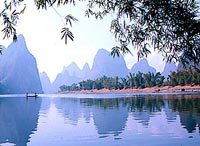
The 437-kilometer-long Lijiang River, a branch of the Pearl River, runs from the Mao’er Mountains north of Guilin through Yangshuo and Pinle to Wuzhou, where it joins the Xijiang River.
A trip along the Lijiang is one of the highlights of a holiday in China. From Guilin to Yangshuo, the river meanders through 83 kilometers of beautiful countryside, with bamboo forests, dense reed-beds and spectacular rock formations.
But the water in the Lijiang has been unusually low since November, with some sections even drying up completely. The water level fell to its lowest point since 1950, and only 10 kilometers of the river sightseeing cruise from Guilin to Yangshuo was open in February. Those wishing to see the river had to go on foot.
Moderate to heavy rainfall in March brought the water back up, enabling regular waterway traffic to resume at the end of the month.
The water in the Lijiang began to rise on March 18, and has now reached 141.6 meters with a flow of 122 cubic meters per second, according to Huang Kun’an, chief of the River Condition Department of the Guilin Hydrology Monitoring Station.
The unusually low levels of the river this winter are directly attributed to scant rainfall during the latter half of 2003.
By December 3, 2003, the water in the Lijiang had dropped to 140.5 meters with the flow rate down to 11 cubic meters per second, a rare phenomenon during the past 50 years. By January 9 of this year, the flow rate had dropped to only 8.5 cubic meters per second. The Law of Navigation Management required that navigation be suspended.
But the Lijiang river cruise is one of the most popular tours in the country, and suspending navigation would hit the tourism market hard. The local government launched an emergency initiative to keep the cruises going.
The Qingshitan Reservoir was down to 205.7 meters and holding only 59.5 million cubic meters of water, 100 million cubic meters less than usual. Supplying the Lijiang was considered so important that water normally dedicated to crop irrigation was used to refill the river instead.
But it was not only the lack of rainfall that caused the Lijiang River to run dry.
The forest coverage on the Mao’er Mountains steadily fell from the 1950s to the 1990s. Forested area, which accounted for some 40,000 hectares in 1958, had plummeted to 17,700 hectares by 1980. That year, a reforestation program was implemented and now the amount of forested land has risen back up to 30,800 hectares.
But the new tree coverage cannot undo all the damage that was done. The land was badly eroded, and now no longer able to hold the water, floods are frequent during the rainy season while the dry seasons grow longer and longer. Since the latter half of the 1990s, dry-season suspension of navigation has been extended by one to three months.
Even now, economic development is still based on traditional exploitation of the local forest. The number of lumber mills continues to creep up, while loggers threaten the protected zones.
Excessive and poorly planned development of the tourism industry is another factor.
In recent years, countless restaurants have opened their doors along the riverside, even in the more remote locations. The larger tourist attractions consume enormous amounts of water in their operations.
The Lijiang River is unparalleled for its beauty, and the tour and travel trade there is vitally important to the area’s economic development. Yet stopgap measures will not solve the problems the Lijiang is experiencing now: viable long-term solutions must be found.
(China.org.cn by Wang Zhiyong, April 5, 2004)
|

